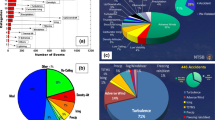Abstract
We present the experimental data which show that backscattered signals at the wavelength of 532 nm correlate with parameters which determine the plasma content in the nocturnal F 2 layer of the ionosphere. Based on analysis of lidar data and the geophysical situation, we discuss the hypothesis of a possible role of highly excited Rydberg atoms in the formation of lidar returns from ionospheric altitudes.
Similar content being viewed by others
References
V. V. Bychkov and B. M. Shevtsov, “Dynamics of lidar reflections of the Kamchatka upper atmosphere and its connection with phenomena in the ionosphere,” Geomag. Aeronom. 52(6), 797–804 (2012).
K. Shiokawa, Y. Katoh, M. Satoh, M. K. Ejiri, T. Ogawa, T. Nakamura, T. Tsuda, and R. H. Wiens, “Development of Optical Mesosphere Thermosphere Imagers (OMTI),” Earth Planets Space 51, 887–896 (1999).
Yu. A. Nepomnyashchii, A. S. Perezhogin, and B. M. Shevtsov, “Study of the dynamics of highly excited states of atoms of the upper atmosphere,” in Abstracts of the VI International Conference “Solar-Terrestrial Connections and Physics of Earthquake Precursors,” Paratunka, Kamchatskii Krai, September 9–13, 2013, p. 18.
M. G. Deminov and V. V. Khegai, “Analytical approximation of the rate of ionization by auroral electrons,” Geomagnet. Aeronom. 20(1), 145–147 (1980).
S. V. Avakyan and N. A. Voronin, “Condensation Process in the low atmosphere and microwave radiation of the Sun and ionosphere,” in Proc. 6th Inter. Conf. “Problems of Geocosmos,” Saint-Petersburg, May 23–27, 2006, pp. 24–28.
Encyclopaedia of Physics, Ed. by A.M. Prokhorov (Bol’shaya Rossiiskaya Entsiklopediya, Moscow, 1994), pp. 277–282 [in Russian].
S. M. Tarr, J. A. Shiavone, and R. S. Friend, “Long-lived high-Ridberg molecules formed by electron impact: H2, D2, N2, and CO,” J. Chem. Phys. 74(5), 2869 (1981).
P. M. Banks and G. Kokartis, Aeronomy (Acad. Press, N. Y., 1973).
G. V. Golubkov, M. G. Golubkov, I. V. Karpov, and A. Z. Devdarini, “Radiation of highly excited atoms and molecules in the upper atmosphere,” Khim. Fiz. 30(5), 75–79 (2011).
A. E. S. Green and R. S. Stolarski, “Analytic models of electron impact excitation cross sections,” J. Atmos. and Sol._Terr. Phys. 54, 1703–1717 (1972).
Author information
Authors and Affiliations
Corresponding author
Additional information
Original Russian Text © V.V. Bychkov, Yu.A. Nepomnyashchii, A.S. Perezhogin, B.M. Shevtsov, N.M. Polekh, 2014, published in Optika Atmosfery i Okeana.
Rights and permissions
About this article
Cite this article
Bychkov, V.V., Nepomnyashchii, Y.A., Perezhogin, A.S. et al. Lidar returns from the upper atmosphere of Kamchatka according to observations in 2008. Atmos Ocean Opt 27, 297–302 (2014). https://doi.org/10.1134/S1024856014040058
Received:
Published:
Issue Date:
DOI: https://doi.org/10.1134/S1024856014040058




